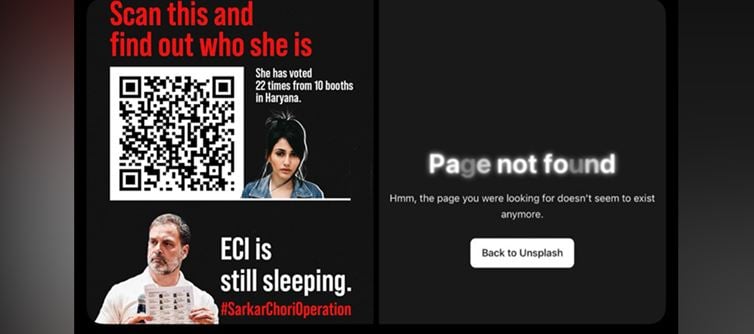
A ‘Hydrogen Bomb’ That Shook the Polling Booths
When rahul Gandhi dropped what he called a “Hydrogen Bómb” — alleging mass manipulation in Haryana’s rolls and pointing to a Brazilian model’s photo appearing multiple times — the political world convulsed. Screenshots, spot checks, and sensational claims spread like wildfire. Within hours, a new allegation went viral: the election commission had quietly removed the source page for voter-card downloads, making the evidence impossible to verify. The reaction was immediate — outrage, suspicion, conspiracy — because in a functioning democracy, data is the oxygen of accountability. Today, the oxygen smells faint.
1) THE ALLEGATION — A MODEL, 22 NAMES, 25 LAKH FAKE VOTERS
Rahul’s presentation accused a centralized operation of inserting bogus names across Haryana: duplicate electors, invalid addresses, mass registrations — and, emblematic of the charge, a Brazilian model’s photograph allegedly reused 22 times under different names. He claimed up to 25 lakh irregular entries that could have swung outcomes — a claim designed to terrify and galvanize. Whether you accept the math or not, the accusation raised a single civic demand: show us the data.
2) THE VANISHING SOURCE — DID THE EVIDENCE DISAPPEAR?
Social feeds lit up with a single complaint: the election Commission’s public portal no longer showed the voter-card source page that Rahul’s team had used for its analysis. If true, this wasn’t a technicality — it was erasure. Deleting or restricting access to primary electoral data after a public allegation is the shortest path from transparency to cover-up. Critics screamed “NDA: No Data Available,” and demanded answers. Several outlets flagged both the claim and the panic it caused.
3) THE ECI RESPONSE — DENIALS, FACT-CHECKS, AND ‘FAKE NEWS’ FLAGS
The poll body didn’t stay silent long. The election commission issued denials and fact-checks, rejecting claims that it had pulled voter lists from public access and insisting that electoral rolls remain downloadable from the official portal. In short, the claim that the ECI “deleted the evidence” was labelled false by the Commission itself, which urged citizens to rely on the official site. That rebuttal matters — but so does why the claim spread and why so many believed it immediately.
4) WHY THE DENIAL ISN’T ENOUGH — TRUST Has a Half-Life
A denial on an official handle doesn’t magically erase suspicion. When political actors present explosive charges in a highly visual, simplified form — PowerPoints, labelled photos, viral soundbites — ordinary citizens expect to be able to verify them. If the public or journalists struggle to reproduce the findings, trust evaporates, and the vacuum fills with rumor. That’s the real danger: whether or not data was removed, the public perception became one of opacity. And perceived opacity is as corrosive as real corruption.
5) politics BY POWERPOINT — THE DANGERS OF SPECTACLE EVIDENCE
politics has always been theater, but evidence masquerading as spectacle is a new and dangerous play. A single dramatic reveal can define national conversation for days, even when underlying claims are contested. PowerPoint allegations must be accompanied by open, verifiable data and a clear forensic trail — otherwise, a democracy devolves into competing mythologies. Rahul’s “H-Bomb” raised serious questions; the response should have been to hand over a reproducible dataset, not escalate the spin cycle.
6) THE MEDIA’S ROLE — VERIFY, DON’T VIRALIZE
Journalists have two tasks now: verify the claims and hold authorities to account. Sensational claims require hard replication. Reporters should demand booth-by-booth extracts, EPIC-ID crosschecks, and explanations from returning officers — and then publish the results in full. When media outlets amplify allegations without publishing reproducible data, they don’t expose wrongdoing — they catalyze confusion. The public deserves verification, not volume.
7) THE REAL TEST — TRANSPARENCY, AUDIT, AND COURTROOMS, NOT JUST SOUND BITES
If the claim of large-scale manipulation is true, the remedy is legal and technical: independent audits, sample cross-verifications, constituency-wise forensic review, and judicial scrutiny. If the claim is false, the remedy is institutional — stronger public access controls, clearer logs, and public proof that data was never removed. Either way, the fix is not rhetorical theater; it is methodical, documented scrutiny. Democracy needs processes that make explosive claims resolvable — not permanently ambiguous.
EPILOGUE — DATA OR DEMAGOGUE: WHICH WILL WIN?
The ECI’s denials matter. rahul Gandhi’s presentation matters. What matters more is this: a functioning republic cannot survive long on spectacle and denials alone. If data truly exists and is accessible, publish it. If data was pulled for technical reasons, explain the timeline and restore access with an audit log. If neither happens, the vacuum will be filled by rumor, fury, and further erosion of faith. The simplest test of democratic health right now is also the hardest: can India’s institutions make explosive allegations resolvable, not permanent? The public deserves answers — not distractions.




 click and follow Indiaherald WhatsApp channel
click and follow Indiaherald WhatsApp channel